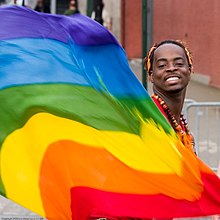User:Jacquelinebachrach/LGBT stereotypes
Bisexual Stereotypes
[edit]Indecision
[edit]Many bisexual people are often characterized as indecisive due to their attraction to both men and women. As the term bisexual can refer to people who do have a sexual preference but are open to sexual interactions with other groups, bisexuals are sometimes seen as unwilling to commit to one sexual identity. This characterization can include stereotypes originating in the LGBT community itself a people who are bisexual do not always choose homosexual partners- they are often seen as being in a transitory or experimental phase between being heterosexual and homosexual[1]

Promiscuity
[edit]Another common stereotype is that bisexual people are promiscuous and incapable of having steady or long-term relationships. This includes belief that, according to a bisexuality study, “compared to lesbians or gay targets, bisexual targets in a relationship with lesbian or gay partners were evaluated as more likely to transmit STDs and less likely to sexually satisfy their partners.” by the public.[2] Bisexual people are sometimes seen as being incapable of monogamy or sexually manipulative. Some examples of Bisexuals portrayed this way in media are Oberyn Martell in Game of Thrones and T-Bag from Prison Break.
Due to negative characterizations of bisexuality, media personalities are often reluctant to share their identity with the public, leading to reduced visibility. David Bowie is a famous public figure who was openly bisexual, a detail which he revealed he wished he had kept private as it led to misunderstandings of bisexuality and his persona by the public
Intersections between LGBT, race, and class stereotypes
[edit]Intersectionality
[edit]The concept of intersectionality dictates that discrimination leveled against an individual can compound based on a number of factors including race, class, gender, and sexuality[3]As members of the LGBT community can be members of other minority groups and stand at all ends of the socioeconomic spectrum, intersectional stereotypes are often perpetuated, including those related to class and race. As people of color and those of lower socioeconomic status are more likely to go to prison, LGBT members of these groups are often misrepresented as being criminally inclined.[4] LGBT individuals often face discrimination in prisons as they are typically gender-segregated and are stereotyped as being sexually available to other prisoners. This makes them vulnerable to assault and discrimination both behind bars and in the outside world[5] Shows like Orange is the New Black and other media perpetuate stereotypes of LGBT expression within prisons.

African Americans
[edit]African American gay men are often characterized as being dominant in relationships both sexually and emotionally.[6] This bias stems from a history of racism and characterization of African American men as brutish in addition to stereotypes which categorize homosexual men as either “top” or “bottom”. These stereotypes can be observed in many forms of media, including pornography which depicts gay African American men as aggressive. African American members of the LGBT community also face discrimination and stereotypes from other African Americans who are historically likely to be religious and stereotype homosexuals as having loose morals. Religious stereotypes surrounding the LGBT community are especially prevalent in certain Black evangelical churches where gay and transsexual members are thought to be "damned to hell".
References
[edit]- ^ "GLAAD Media Reference Guide - In Focus: Covering the Bisexual Community". GLAAD. 2014-07-22. Retrieved 2020-05-07.
- ^ Zivony, Alon; Lobel, Thalma (2014-02-21). "The Invisible Stereotypes of Bisexual Men". Archives of Sexual Behavior. 43 (6): 1165–1176. doi:10.1007/s10508-014-0263-9. ISSN 0004-0002.
- ^ Crenshaw, Kimberle (1991-07). "Mapping the Margins: Intersectionality, Identity Politics, and Violence against Women of Color". Stanford Law Review. 43 (6): 1241. doi:10.2307/1229039. ISSN 0038-9765.
{{cite journal}}: Check date values in:|date=(help) - ^ Knight, Charlotte; Wilson, Kath (2016), "LGBT People as Offenders within the Criminal Justice System", Lesbian, Gay, Bisexual and Trans People (LGBT) and the Criminal Justice System, Palgrave Macmillan UK, pp. 85–111, ISBN 978-1-137-49697-3, retrieved 2020-05-07
- ^ [(https://transequality.org/sites/default/files/docs/resources/TransgenderPeopleBehindBars.pdf) "Transgender People Behind Bars"]. transequality.org.
{{cite web}}: Check|url=value (help)CS1 maint: url-status (link) - ^ Robinson, Russell. "LGBT Equality and Sexual Racism" (PDF). Fordham Law Review. 86: 2739–2754.
